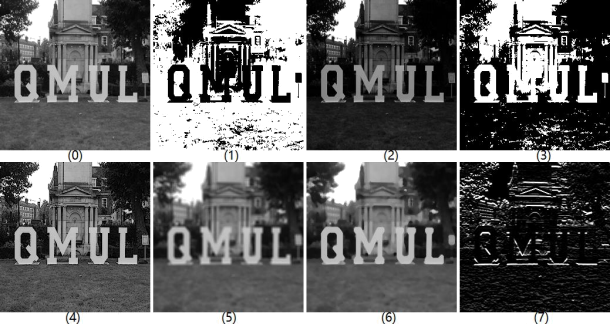关键词 > ECS776P
ECS776P IMAGE PROCESSING Summer Examination Period 2022
发布时间:2024-05-15
Hello, dear friend, you can consult us at any time if you have any questions, add WeChat: daixieit
Summer Examination Period 2022 - May/June - Semester B
ECS776P IMAGE PROCESSING
Question 1
Consider the 4x5 image with a dynamic range of [0-9] as in Figure 1:
|
S1 |
S2 |
S3 |
S4 |
S5 |
|
S1 |
S9 |
S8 |
S7 |
S6 |
|
0 |
S1 |
S7 |
S7 |
S6 |
|
9 |
0 |
S6 |
0 |
S5 |
Figure 1: An image of size 4x5
where S1-S2-S3- …S8-S9 are the 9 digits of your student number, from left to right.
For example, if your student number is 123456789, the original image you use for this question is
|
1 |
2 |
3 |
4 |
5 |
|
1 |
9 |
8 |
7 |
6 |
|
0 |
1 |
7 |
7 |
6 |
|
9 |
0 |
6 |
0 |
5 |
If your student number is 987654321, the original image you use for this question is
|
9 |
8 |
7 |
6 |
5 |
|
9 |
1 |
2 |
3 |
4 |
|
0 |
9 |
3 |
3 |
4 |
|
9 |
0 |
4 |
0 |
5 |
Note that a few pixel values are independent of your student number.
(a) Give the bit-planes of the image in Figure 1. [8 Marks]
(b) Find the transformation for histogram equalisation of the original image in Figure 1 and give the resulting image after histogram equalisation has been applied. [10 Marks]
(c) Give the formulas for power-law and apply it with power 0.4 to the original image in Figure 1 for intensity power-law transformation preserving the dynamic range from 0 to 9.
Question 2
Consider the 4x5 image with a dynamic range of [0-9] as in Figure 2:
|
S1 |
S2 |
S3 |
S4 |
S5 |
|
S1 |
S9 |
S8 |
S7 |
S6 |
|
0 |
S1 |
S7 |
S7 |
S6 |
|
9 |
0 |
S6 |
0 |
S5 |
Figure 2: An image of size 4x5
where S1-S2-S3- …S8-S9 are the 9 digits of your student number, from left to right.
For example, if your student number is 123456789, the original image you use for this question is
|
1 |
2 |
3 |
4 |
5 |
|
1 |
9 |
8 |
7 |
6 |
|
0 |
1 |
7 |
7 |
6 |
|
9 |
0 |
6 |
0 |
5 |
Note that a few pixel values are independent of your student number.
(a) Calculate the entropy of the image in Figure 2. [5 Marks]
(b) Find the Huffman code of the image in Figure 2, and give its bit rate. [14 Marks]
(c) Convert the image in Figure 2 into a binary image with a threshold of 5, and give the run-length code for the resulting binary image. [6 Marks]
Question 3
(a) In Figure 3, the first image (0) is the original image and all the other images (1)-(7) are the results of the application of some image processing operations on (0). Identify what operation has been used to produce each of the images (1)-(7) from image (0), and explain your answers.

Figure 3: Original image (0) and the processed results (1-7) [15 Marks]
(b) After edge detection operation is applied to an image of dynamic range from 0 to 255, give two methods in mathematical terms to transform pixel values of the resulting image to better show the edges. [5 Marks]
(c) Suppose that a medical image of size 1000x2000 covers an object of 5cm by 10cm. Answer the following questions:
i) What is the pixel size of the image?
ii) If the image has 3 components and the pixel values of two components are between 20 and 120, and the pixel values of the other component are between 50 and 250, how many megabytes do we need to store the whole image without compression? [5 Marks]
Question 4
Consider the 3x3 image with a dynamic range of [0-9] as in Figure 4:
|
S1 |
S6 |
S7 |
|
S2 |
S5 |
S8 |
|
S3 |
S4 |
S9 |
Figure 4: An image of size 3x3
where S1-S2-S3- …S8-S9 are the 9 digits of your student number, from left to right.
For example, if your student number is 123456789, the original image you use for this question is
|
1 |
6 |
7 |
|
2 |
5 |
8 |
|
3 |
4 |
9 |
(a) For the 3x3 image in Fig. 4, show the result of the convolution with the Laplacian mask. Indicate where the edges could be detected and explain why. Use replicate border extension for the convolution. [12 Marks]
(b) For the 3x3 image in Fig. 4, show the result of the median filtering. Use mirror border extension for the operation. [8 Marks]
(c) What can the following filter be used for? How can a more generalised version be found with this mask?
 [5 Marks]
[5 Marks]

